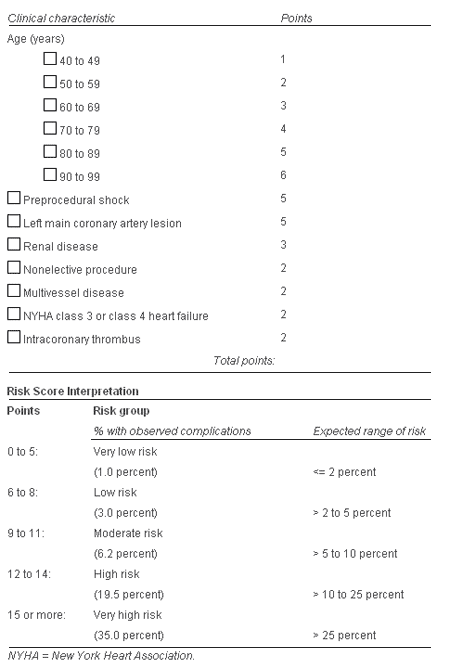
Am Fam Physician. 2004;70(10):1966-1968
This guide is one in a series that offers evidence-based tools to assist family physicians in improving their decision making at the point of care. The series is published in partnership with Family Practice Management. A related article appears in the November/December issue of FPM, pages 71–2.
Clinical Question
What is the likelihood of in-hospital complications in a patient undergoing coronary angioplasty?
Evidence Summary
Percutaneous coronary interventions, such as balloon angioplasty, with or without stent placement, are important in the treatment of patients with coronary artery disease. Several clinical decision rules have been developed and validated to estimate the likelihood of short-term, in-hospital complications such as death, myocardial infarction, and urgent coronary artery bypass graft surgery. The characteristics of four of these rules1–4 are summarized in Table 1. These four rules were selected because each one has been validated in a group of patients that was distinct from the group that was used in the rule’s development.
| Clinical rule | Population* | Data source | Definition of complications (frequency in validation studies) | Number of variables | Type of validation | ROC area (development/validated)† |
|---|---|---|---|---|---|---|
| Kimmel, et al.1 | Mean age, 62 years; 68% male; 15% had diabetes | National angioplasty registry, using data from 1992 and 1993 | Death, MI, or emergent bypass surgery (2.0%) | 7 | Developed in 10,622 patients using data from 1992; validated prospectively in 10,030 patients using data from 1993. | 0.71/0.65 |
| Singh, et al.2 | Mean age, 66 years; 70% male; 22% had diabetes‡ | Mayo Clinic registry of all angioplasty procedures between 1996 and 2000 | Death, MI, urgent or emergent bypass surgery, or stroke (3.2%) | 8 | Developed in 5,463 patients using data from 1996 through 1999; validated prospectively in 1,781 patients using data from 2000 | 0.78/0.76 |
| Resnic, et al.3 | Mean age, 64 years; 68% male; 17% had diabetes | Prospective data collection at Brigham and Women’s Hospital from 1997 to 1999 | Death, MI, or same-day bypass surgery (6.6%) | 8 | Single sample of 2,804 patients randomly split into two groups to construct a model (1,877 patients) and confirm model discrimination (927 patients); an additional 1,460 patients were used to validate model prospectively | 0.81/0.74 |
| Fortescue, et al.4 | Mean age, 62 years; 70% male; 21% had diabetes | Prospective data collection at 12 medical centers between 1993 and 1995 | Death, renal failure, MI, cardiac arrest, stroke, or coma (3.2%) | 14 | Single sample split into two groups, with 9,286 patients used to develop rule and 4,744 patients used to validate rule | 0.80/0.82 |
All of the rules are simple scoring systems in which points are assigned for different clinical characteristics. They all studied patients with a mean age between 62 and 66 years, of whom about 70 percent were men, and 15 to 22 percent had diabetes. However, there are important differences between the rules. For example, the number of characteristics used in a rule varies from seven1 to 14.4 In general, a simpler rule is preferred at the patient’s bedside. Another characteristic to consider is the age of the data on which the rule is based, which may be important, especially because the technology of angioplasty and stenting continues to evolve. The rules of Kimmel,1 developed from 1992 to 1993, and Fortescue,4 derived from 1993 to 1995, were derived from data that are older than those used in the rules by Resnic,3 developed from 1997 to 1999, and Singh,2 derived from 1996 to 2000. Fortescue’s rule4 was validated using a split-sample technique in which a single sample of patients is split randomly into two groups, with the first group used to develop the rule and the second to validate it. The two newest rules developed by Singh2 and Resnic3 do a better job of validation, developing the rule first in one group of patients and then prospectively validating it in a new group of patients.
The Singh decision rule (Figure 12) is among the newest and best validated rules, and because it has only eight clinical variables, it is relatively easy to use at the patient’s bedside. This rule does not require an assessment of the angiographic complexity of the lesion,5 so it is more useful for primary care physicians communicating with their patients. It can be added easily to a spreadsheet for use on a handheld or desktop computer. The Singh rule helps the clinician appreciate the importance of increasing age, shock, left main coronary artery lesion, and renal disease as risk factors for complications from angioplasty. Patients with these risk factors may warrant more careful observation following their procedure.
Applying the Evidence
Mr. Smith is a 63-year-old man who presents to his family physician with typical anginal chest pain. He is about to undergo coronary artery catheterization with possible angioplasty and stent placement, and would like to have a more precise idea of the risk of complications. Because he does not have shock, renal disease, or heart failure, he has a baseline risk score of three points (very low risk of complications) based on age. If he has a left main coronary artery lesion, his risk score increases to eight points (low risk), and if he has both left main coronary artery lesion and multivessel disease, his risk of complications increases to 10 points (moderate risk). The expected range for his risk of complications in these strata is greater than 5 to 10 percent, with an observed rate of procedure complications of 6.2 percent. Based on the risk assessment, Mr. Smith decides to go ahead with the procedure.
